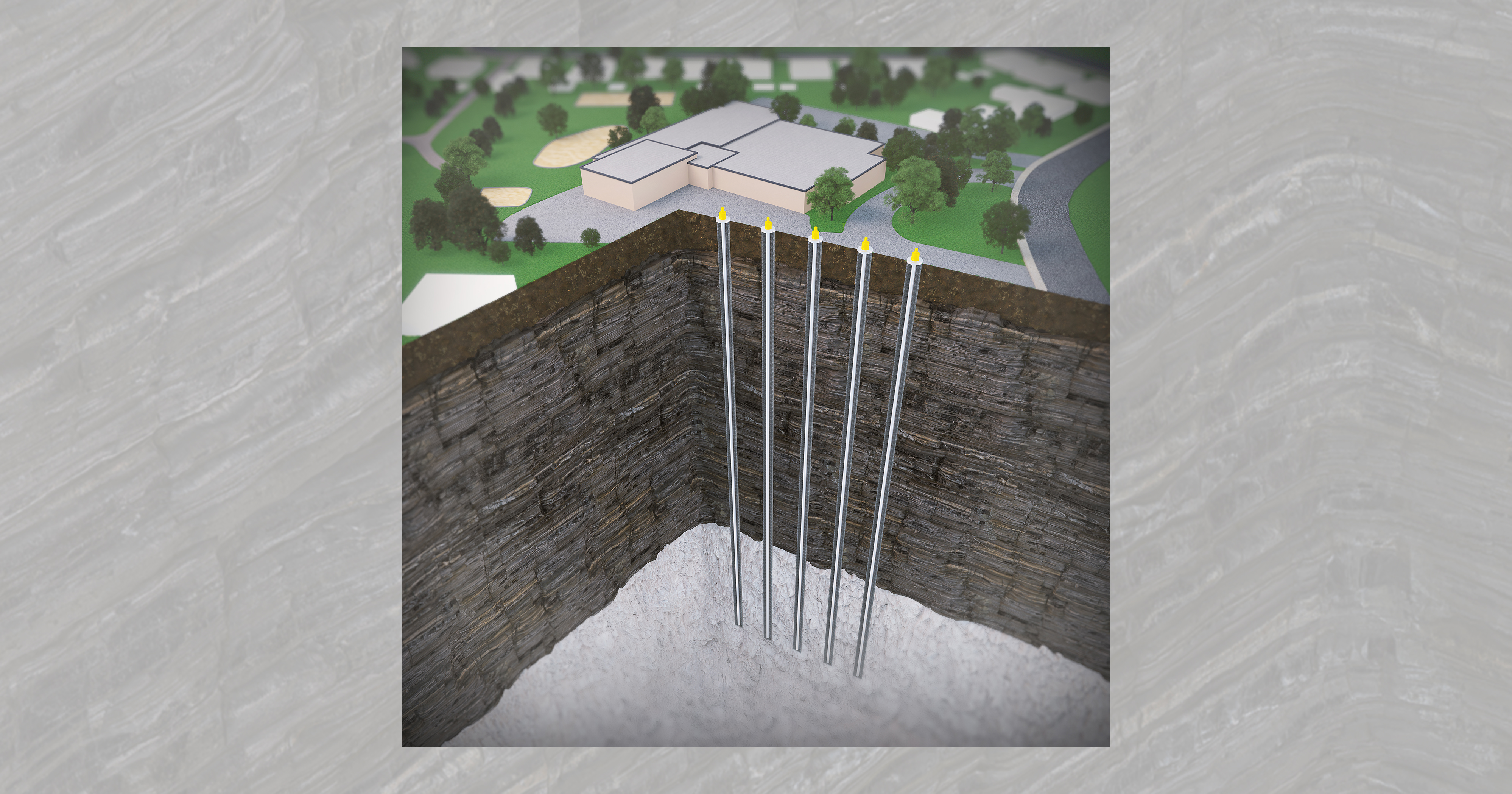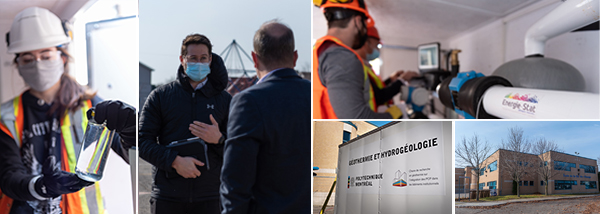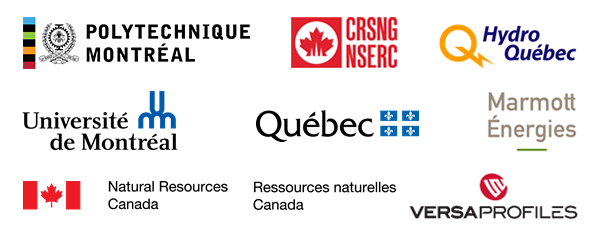Geothermal energy: newly-launched project will bring enviro-energy production to Québec schools faster

Montréal - Polytechnique Montréal, Hydro-Québec, the Centre de services scolaire de Montréal, the Centre de services scolaire de la Seigneurie-des-Mille-Îles, the Centre de services scolaire des Samares, Natural Resources Canada’s CanmetENERGY Research Centre, the Université de Montréal, and companies Versaprofiles and Marmott Energy have aligned forces with the Ministère de l’Éducation du Québec (MEQ) to reduce greenhouse gas emissions and improve building energy efficiency. The above-mentioned partners today officially launched Project Alliance – an initiative focussed on the use of geothermal standing column wells (SCW) to efficiently supply energy to commercial and institutional buildings.

As part of Project Alliance, a geothermal energy system comprising five standing column wells (SCW) will be built in the area around Clé-des-Champs primary school, in Saint Augustin, Mirabel. (Credit: Massouh bioMEDia for Polytechnique Montréal)
Polytechnique Montréal’s Professor Philippe Pasquier – who is also Chaire de recherche en géothermie sur l'intégration des PCP dans les bâtiments institutionnels (unofficial transl: Geothermal Energy Research Chair – Use of SCW in Institutional Buildings) will lead the 10-researcher strong team. Over the course of Project Alliance, the latter group will create three successive demonstration projects in three Québec schools, as well as 24 complimentary research activities over five years. In fact, the team’s work is already underway, with field trials having lead to the construction of the first SCW at Mirabel’s École Clé-des-Champs primary school.
Notably, Project Alliance will benefit from $2.7 million in funding from several sources: Hydro-Québec ($1 million), and the Natural Sciences and Engineering Research Council of Canada – NSERC ($1.7 million). The MEQ will look after costs associated with the construction of geothermal energy systems, while other partners will provide contributions equaling $1.1 million in labour costs.
NSERC Alliance funding contributions are intended to assist the establishment of collaborations between university researchers and private, public, and non-profit sector partner organizations, in order to produce new knowledge and accelerate the application of research results – namely by creating expertise and qualified labour within Canada.
Demonstrating SCW Effectiveness
Buildings are the third-highest emitters of greenhouse gases in Canada – largely due to their consumption of fossil fuels via energy use. In 2016, buildings contributed 81 megatonnes of GHG – surpassing the 78.5 megatonnes of GHG that the entire province of Québec emitted in that same year.
Over the years, numerous ideas to reduce the staggering amount of GHG emissions have been considered. Notably, the use of conventional geothermal system technologies has been one such solution, as this technology permits buildings to be heated and cooled via heat pump, coupled with closed-loop wells. The latter solution has proven difficult to adopt however, due to elevated construction costs and the density of urban buildings.
Contrary to conventional geothermal systems, SCW plunge into the earth to some 500 metres depth, and use immediately available groundwater. As a result, SCWs do not take up extensive space, and represent a promising option to reduce the power grid drain that Hydro-Québec faces during peak periods.
Despite this promise, the adoption of SCW technology has been slow in Canada, largely due to the system’s complexity, a lack of demonstration projects, a lack of qualified industry-specific labour, and the fear that groundwater will be negatively affected. Lead by Professor Pasquier, Project Alliance seeks to resolve and remove each one of these barriers to SCW adoption and use.
Quotes
“SCWs have already been used for some 30 years in the North-Eastern United States. Their strength resides in the massive thermal power they create, which makes them a very cost-effective approach versus conventional geothermal energy production in use right now. The absence of demonstration projects and of experienced labour in Canada represents a major stumbling block to SCW deployment. We have great hope that this project will change that, while at the same time confirm SCW’s safety in terms of groundwater.” - Polytechnique Montréal’s Professor Philippe Pasquier, Chaire de recherche en géothermie sur l'intégration des PCP dans les bâtiments institutionnels (unofficial transl: Geothermal Energy Research Chair – Use of SCW in Institutional Buildings.
“Professor Pasquier’s research work perfectly embodies the way that NSERC Alliance grants permit partner organizations to offer their perspectives and skills in order to achieve desired results. This partnership will reduce barriers to SCW use, so as to improve energy efficiency - all while ensuring the development of highly qualified industry labour through the direct training of some 30 students. We’re eager to see the results of this promising collaboration.” - Marc Fortin, Vice-President of Research Partnerships at the Natural Sciences and Engineering Research Council of Canada
“The energy sector is in transformation and the energy transition is well underway. Carbon reduction technology and diversified energy production options are at the heart of these changes. The Chair’s work on geothermal energy standing column wells is part of our vision for this effort. This research is a way to develop our cutting–edge knowledge and know-how, and to provide a complimentary solution that is both effective and economically attractive, namely for the commercial and institutional sectors. It also permits us to assess the potential of a promising technology with research that is complementary to what we are doing here at the Research Centre in terms of working on technologies to reduce carbon reliance in Québec.” - Jean Matte, Senior Director, Hydro-Québec Research Institute.
“We’re proud to be partners with Project Alliance, which focuses on the use of standing column wells which will assist the development of geothermal energy technology, while demonstrating its effectiveness in real-world conditions. The Centre de services scolaire de la Seigneurie-des-Mille-Îles is on the cutting edge of energy efficient systems, and already uses geothermal heating systems for 15% of its school buildings. The latter energy system has permitted air quality in buildings to improve all while reducing energy costs by 35%, in comparison to conventional mechanical systems (which cost an estimated $55,000 per year on average, in Québec). Geothermal technology will no doubt help support our main focus – educational success.” - Guillaume Marchand, Projects Coordonnator, CSSMI Material Resources Services
“Our participation in this project meets the goals of our Plan d’action énergétique (unofficial transl: Energy Action Plan) launched in 2007 and regularly updated since that date. Among other elements, the latter plan seeks to foster energy performance improvements in collaboration with our partners. Potential energy savings meet our own goals to create financial savings, all while having a beneficial effect on the environment.” - Robert Gendron, General Director, Centre de services scolaire de Montréal (CSSDM).
“The Government of Canada has committed to reducing greenhouse gas emissions by 30% in terms of their 2005 levels from now until 2030, and by 80% from now until 2050. Heat pumps have been identified as a key technology to heat buildings – especially in the context of carbon reliance reduction in networks, and in the electrification of applications. Geothermal heat pumps using standing column wells represent a highly appealing solution for Canada’s cold climate.” - Sophie Hosatte-Ducassy, Director, Buildings Groupe, CanmetENERGY in Varennes.
“Reducing greenhouse gas emissions (GHG) and improving energy efficiency in buildings is very important for us. I am proud to see that our educational institutions are at the heart of the solution, and are playing a major role in the democratization of innovative technologies. I am convinced of the soundness of these projects and efforts, which will certainly have a major impact on the way we think about building and buildings in the future.” - Jean-François Roberge, Ministre de l’Éducation du Québec
“I am thrilled that Polytechnique Montréal is enthusiastically addressing climate change by focusing on energy efficiency and the reduction of greenhouse gas emissions. I am convinced that this research and development will result in concrete advances. I thank all those involved in this project, and wish them the utmost success.” - Danielle McCann, Ministre de l’Enseignement supérieur du Québec
“The way we produce and use the energy we need plays major role in our victory over climate change. This wonderful project is another example that demonstrates our government’s proactive approach in this area, and I am convinced that it will lead to a notable improvement in the way we approach energy. I thank all those who have played a role in the concretization of this project.” - Jonatan Julien, Ministre de l’Énergie et des Ressources naturelles; Minister responsible for the Côte-Nord region
“Versaprofiles is proud to be involved with a project that will help build researchers’ and Québec companies’ skills in the field of geothermal energy standing column wells. Results demonstrate that the use of plastic products can in fact be a part of environmentally-responsible solutions to save our planet.” -Jean-François Lavoie, Operations Director, Industrial Piping, Versaprofiles
“Marmott Énergies is pleased to be a part of the development of this very promising technology, and is pleased to be able to intensify its work with researchers in this field. The large-scale realization of a developmental SCW project in 2018 enabled us to really understand the relevance of the Chair’s research, in order to reduce the uncertainty and complexity inherent to the project. We hope that this will lead to increased geothermal energy use, that will replace the use of fossil fuels in large urban buildings.” - Nathalie H. Tremblay, President & Founder, Marmott Énergies
Fast Facts
- Canadian commercial and industrial sector energy costs reached $20.6 billion in 2013
- Geothermal systems that use standing column wells (SCW) can reduce energy consumption up to 60% in commercial and industrial buildings
- With a $2.7 million budget over 5 years, the research will create 3 demonstration projects, 24 complimentary research activities, and will contribute to training 34 students
-30-
MEDIA KIT INCLUDES B-ROLL, PHOTOS AND 2D PLAN OF WORKS
B-Roll: https://bit.ly/2Url19z
Photos: https://bit.ly/3lxiFBR
Graphics: https://bit.ly/38BGy7P

Project Alliance website (in French only): www.polymtl.ca/geothermie/



